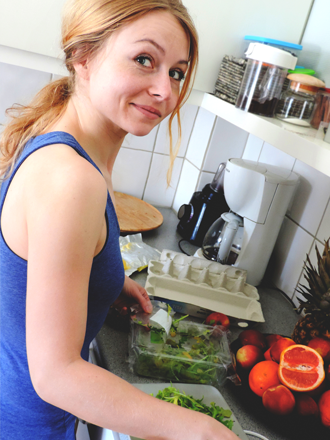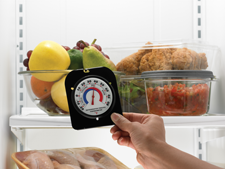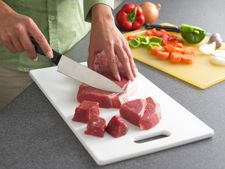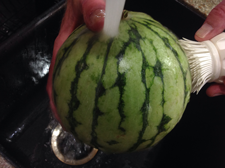Author: Alice Henneman, MS, RDN

Restaurants must pass regular food safety inspections to stay open. Would YOUR kitchen pass a food safety inspection?
In the United States, the “Food Code"—developed by the U.S. Food and Drug Administration (FDA)—serves as a model to help health jurisdictions nationwide develop food service food safety standards.
For consumers, the U.S. Department of Agriculture (USDA), Centers for Disease Control Prevention (CDC) and FDA work together to provide food safety guidelines for use in the home. NOTE: Consumer guidelines sometimes differ slightly from restaurant guidelines due to such factors as differences in home and professional equipment.
DIRECTIONS: With these guidelines in mind, let’s see if your kitchen would measure up! Choose the answers that most closely apply to YOUR everyday practices in your kitchen. Then compare your answers with the desired practices according to government guidelines for consumers.
1. How long do you leave perishable foods at room temperature? (Examples include meat, poultry, seafood, dairy products and cooked leftovers.)
- 2 or less hours
- No more than 6 hours
- I haven’t paid attention to how much time they are at room temperature
2. What is the temperature of your home refrigerator?
- 50ºF
- 40ºF or below
- I don’t know
3. How do you thaw meat, poultry and seafood products?
- On the kitchen counter
- In the refrigerator
- In the microwave
4. How many days do you usually store perishable leftovers in the refrigerator?
- 3 to 4 days
- A week or more
- My leftovers usually spoil before I get around to eating them
- Use a separate cutting board
- Wipe the cutting board with a damp cloth or sponge
- Wash the cutting board with hot, soapy water, rinse with clear water and air dry or pat dry with clean paper towels
- Cut into it to see if the juices run clear
- Check if it is no longer pink in the middle
- Use a food thermometer
- I wash my hands before preparing food
- I wash my hands before, during and after preparing food
- I don’t wash my hands during food preparation
- Wash poultry and meat under running water before cooking them
- Give poultry and meat a quick dunk in a sink or large pan filled with cold water before cooking them
- Cook poultry and meat without washing them
- Cut melons open and examine how they look
- Wash melons thoroughly under running water before cutting into them
- Wash melons with soap and water before cutting into them
Answers to food safety inspection questions
 2. b. 40ºF or below: Your refrigerator should be between 40ºF and 32ºF. Your freezer should be at 0ºF. Use an appliance thermometer to assure your refrigerator and freezer are cold enough. NOTE: Freezing doesn’t destroy bacteria but keeps them from growing in food products until you cook the food. Quality should remain high for most frozen foods for 3 –
2. b. 40ºF or below: Your refrigerator should be between 40ºF and 32ºF. Your freezer should be at 0ºF. Use an appliance thermometer to assure your refrigerator and freezer are cold enough. NOTE: Freezing doesn’t destroy bacteria but keeps them from growing in food products until you cook the food. Quality should remain high for most frozen foods for 3 –For specific food items and to learn if they might stay fresh longer, see the FoodKeeper app developed by USDA, Cornell University and the Food Marketing Institute:
 5. a. Use a
5. a. Use a
8. c. Cook poultry and meat without washing them: Washing raw meat and poultry can help bacteria spread.
 9. b. Wash melons thoroughly under running water before cutting into them: Wash fruits and vegetables such as melons and orange s even if you plan to remove their peel. Bacteria can spread from the outside to the inside when they are cut or peeled. Suggestions for washing any type of produce include:
9. b. Wash melons thoroughly under running water before cutting into them: Wash fruits and vegetables such as melons and orange s even if you plan to remove their peel. Bacteria can spread from the outside to the inside when they are cut or peeled. Suggestions for washing any type of produce include:- Rinse produce thoroughly under running water. Washing fruits and vegetables with soap, detergent, bleach or commercial produce washes is not recommended.
- Scrub firm produce, such as melons and cucumbers, with a clean produce brush.
- Dry produce with a clean paper towel or cloth towel to further reduce bacteria that may be present on the surface.
References and for further information
- Check Your Steps, retrieved 4/30/2017 at www.foodsafety.gov/keep/basics
- Chill: Refrigerate Promptly, retrieved 4/30/2017 at www.foodsafety.gov/keep/basics/chill/index.html
- Clean: Wash Hands and Surfaces Often, retrieved 4/30/2017 at www.foodsafety.gov/keep/basics/clean/index.html
- Cook: Cook to the Right Temperature, retrieved 4/30/2017 at www.foodsafety.gov/keep/basics/cook/index.html
- Cutting Boards and Food Safety, retrieved 4/30/2017 at www.fsis.usda.gov/wps/portal/fsis/topics/food-safety-education/get-answers/food-safety-fact-sheets/safe-food-handling/cutting-boards-and-food-safety
- FDA Food Code, retrieved 4/30/2017 at www.fda.gov/Food/GuidanceRegulation/RetailFoodProtection/FoodCode
- Leftovers and Food Safety, retrieved 4/30/2017 at www.fsis.usda.gov/shared/PDF/Leftovers_and_Food_Safety.pdf
- Safe Minimum Internal Temperature Chart, retrieved 4/30/2017 at www.fsis.usda.gov/wps/portal/fsis/topics/food-safety-education/get-answers/food- safety-fact-sheets/safe-food-handling/safe-minimum-internal-temperature-chart/ct_index
- Separate: Don’t Cross-Contaminate, retrieved 4/30/2017 at www.foodsafety.gov/keep/basics/separate/index.html
- The Big Thaw–Safe Defrosting Methods–for Consumers, retrieved 4/30/2017 at www.fsis.usda.gov/wps/portal/fsis/topics/food-safety-education/get-answers/food-safety-fact-sheets/safe-food-handling/the-big-thaw-safe-defrosting-methods-for-consumers/CT_Index
- USDA’s Five Tips for a Food Safe Thanksgiving, retrieved 4/30/2017 at www.usda.gov/media/press-releases/2016/11/21/usdas-five-tips-food-safe-thanksgiving
- Washing food: Does It Promote Food Safety? retrieved 4/30/2017 at www.fsis.usda.gov/wps/portal/fsis/topics/food-safety-education/get-answers/food-safety-fact-sheets/safe-food-handling/washing-food-does-it-promote-food-safety/washing-food
Images sources: Woman in kitchen (pixaby.com), refrigerator and cutting board (USDA Image Library), watermelon (Alice Henneman)
